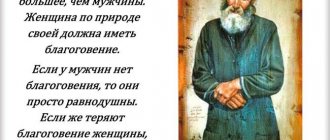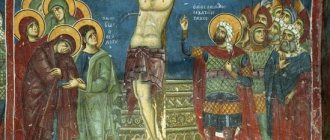Old Testament times and the ancient world
In the Old Testament, in view of the words of the Lord after the creation of man, “ Be fruitful and multiply, and fill the earth
"(Genesis 1:28), marriage was considered an honorable and obligatory state, which is why celibacy and childlessness were usually looked at with contempt. The priesthood was inherited only from father to son. However, already in Old Testament times, exceptional examples of celibacy appeared as a manifestation of chastity - the prophet Elijah is called the first virgin of the Old Testament. In this sense, celibacy appeared, on the contrary, as a special state above marriage.
In the pagan world of classical Greece and Rome, both religion and state condemned celibacy. The state was interested in the marriage union supplying it with the largest possible number of citizens and soldiers, and religious beliefs forced it to take care of procreation. Legislative measures against celibacy existed in Athens and Sparta; in Rome, single people and widows were taxed, condemned, and married people were encouraged with advantages over single people. Augustus's detailed law "Lex Julia et Papia Poppaea", aimed at increasing the number of citizens of a bloodless country, sought to force citizens to view legal marriage as a state service. By this law, the celibate were completely, and the childless partially, infringed on the rights of inheritance under a spiritual will. A set of measures restricting the celibate and encouraging marriage were abolished only by the holy emperor Constantine the Great and his successors under the influence of Christianity.
However, even in the pagan world, the concept of celibacy as an integral part of an exalted spiritual life appeared in Buddhism. Its founder, Gautama Shakyamuni, himself left his wife and children to renounce the world and instructed his disciples to remain celibate.
Motives for voluntary celibacy
They are often associated with psychological complexes that grow from failures in their personal lives. In many countries of the world, there is no sexual education for children, therefore they were forced to learn all the necessary information, first from their father’s videotapes, and then on the street.
Having suffered a couple or dozen failures in relationships with the opposite sex at the age of 15-25, people sometimes become completely disappointed in this area and are forced to look for a replacement for unfulfilled sexual energy in other activities. If this activity becomes religion, it will most likely end in abstinence, and then celibacy.
Orthodoxy in the New Testament era
The concept of celibacy as a manifestation of chastity appeared in the New Testament. Thus, Christ says that those to whom this is given become “eunuchs for the Kingdom of Heaven” (Matthew 19:11-12). Although many of the apostles were married (1 Cor 9:5), the Apostle Paul remained celibate and from his words in I Corinthians it is clear that he leaned towards celibacy mainly due to the fact that it allows one to fully indulge in spiritual life, not needing to take care of the affairs of this world in order to please her husband or wife. However, he preaches only such celibacy, which presupposes the presence of spiritual chastity, devoid of sensual lusts; He himself advises those who are inflamed by passion to get married; finally, chaste celibacy seems to be a special grace of God, which is gifted only to a few (1 Cor 7, 1-2; -9; -34;). Based on this teaching about the height of celibacy, in the first times of Christianity a considerable number of believers devoted themselves to abstinence. In a letter from Ignatius to Polycarp, the first praises the chaste, instructing them, however, not to put themselves above their bishop, who, in all likelihood, had a wife. Athenagoras in his Πρεςβεία περι τών χριςτιανών
(written at the end of 176) speaks of those who grow old in celibacy with the goal of living in closer communion with God.
The strength of the doctrine of the godly celibate life can be seen in Origen's self-castration and in the praise of virginity in the dialogue Convivium inter decem Virgines
of Methodius of Patara, Origen's most ardent opponent. With the passage of time and the strengthening of Christianity, the doctrine of celibacy became increasingly widespread. There were many women who, devoting themselves to the virgin life, considered themselves betrothed to the Lord. Celibacy, as a means and consequence of renunciation of the world and struggle with passions, became a necessary sign of monasticism.
From the first years of Christianity, there was a ban on marriage after entering the clergy. This prohibition is based on the 25th Apostolic Canon, which allows only choristers and clerics to marry after entering the clergy. The Neo-Caesarean Council of 315 threatens to deprive the violator of this rule, and the Ancyra Council of 314 allows the deacon to announce his intention to marry before the ordination, and therefore to carry out his intention after the ordination. Church rules provide for persons admitted to the clergy as celibates to marry at their request while serving in lower clergy positions, and those who do not wish to do so are required to take a vow of chastity before entering the ranks of clergy. Numerous examples from history and church rules also indicate that the Church has always allowed the clergy to remain completely celibate if this was done for the sake of the feat of abstinence.
However, the Church did not consider celibacy obligatory for the clergy. On the contrary, the Apostle Paul points out that a bishop must be a family man, the husband of one wife, able to lead his family, and therefore capable of leading his flock (1 Tim 3:2,4-5). In the first centuries of Christianity, many examples of married bishops are mentioned, not to mention priests and deacons. Already from the first centuries of Christianity, the Church had to fight not only with the ancient contempt for celibacy, but also with another extreme of contempt for marriage, associated with the dualistic teaching of the Gnostics about the denial of the flesh. The Apostolic Canons indicate the compatibility of the sanctity of sacred ministry and married life, prohibiting clergy from leaving their wives under the pretext of piety. At the First Ecumenical Council, numerous supporters of celibacy proposed to prohibit those appointed to the clergy from continuing marital cohabitation with their wives, but Paphnutius, Bishop of Upper Thebaid, a great ascetic and virgin, convinced the fathers of the Council not to impose such a heavy yoke on the initiates, which could bring terrible harm to the morality of the clergy themselves. , and the wives they left behind. The Council of Gangra in the middle of the century pronounces a curse as blasphemers of God-established marriage on all those who, like the supporters of Evgrafiy, Bishop of Sevasta, did not recognize the power of sacred rites performed by married presbyters.
The high concept of virgin life, which allows one to devote oneself entirely to spiritual life and caring for the flock, as well as the emergence of monasticism, which acquired high respect in society and enormous influence on church affairs, determined from the end of the century a restriction on the adoption of the episcopal rank by married people. Thus the custom was established of electing only celibate bishops. In 410, having been elected Bishop of Ptolemais, Sinesius specifically stipulated the possibility of continuing marital cohabitation. Since the century, this custom has become a mandatory rule, initially in state and then in church legislation. Tsar Justinian the Great ordered that monastics or those without wives or those separated from them be appointed bishops. The Council of Trullo in 692 decreed that the wife of a person elevated to episcopal dignity, having previously separated from her husband by common consent, upon his ordination as a bishop, should enter a monastery far removed from the place of residence of this bishop, which, however, is obliged to provide her with maintenance. In addition, the same Council confirmed permission for subdeacons, deacons and presbyters who married before ordination to continue marital cohabitation with their wives, while threatening clergy who married after accepting the priesthood, and bishops who continued marital cohabitation, with deprivation of the priesthood. Thus, within the Eastern Roman Empire, a division was established among the clergy into celibate bishops and monks and married priests and deacons who married before ordination. Although this is not a requirement, little by little the East began to elect bishops exclusively from among monks, probably because of the belief that monastic discipline prepared one well for the high duties of the episcopal office.
In the West, in the Roman Church, the tendency to limit the clergy only to the circle of celibates turned out to be stronger than within the Eastern Roman Empire. The initial measures directed against the married life of the clergy were taken in Spain at the Council of Elvira in 303 or 309, whose decrees prohibited deacons, presbyters and bishops from having marital cohabitation with their wives. The identification of celibacy with the chastity of the clergy allows one to point to a number of papal letters condemning violations of the latter. Thus, in a letter from Pope Siricius to Emerius, Bishop of Tarragona dated 385, which is the first decretal, the authenticity of which is beyond doubt, it is indicated that bishops, priests and deacons who do not observe chastity do not deserve any leniency, since it is necessary to treat with an iron (knife). ) wounds that do not respond to other medications. In two decretals to Bishops Victricius of Rouen and Exsuperius of Toulouse dated 405, Pope Innocent I renewed the above prohibition, threatening defrocking for violation of it. Saints Leo I (443) and Gregory I (590-604) continued to carry out the views of their predecessors. The Councils of Arabsion (441), Arelate 442 or 452), Tours (461), Toledo (653 and 659) established canons asserting the incompatibility of married life with the holiness of the clergy. Finally, the vow of chastity became formally obligatory for priests, deacons and even subdeacons in almost all the Churches of the West. Only the Milan Church in Lombardy, relying on the authority of St. Ambrose, until the end of the century adhered to the same rules that were established in the Eastern Church. In other parts of the Roman Church, the old customs of marriage were maintained despite the prohibitions. Many priests married, others openly had concubines. Over the centuries there have been married priests and even bishops in Italy, Spain, Germany, France and England. Dunstan, Archbishop of Canterbury (961-968), ordered married priests to separate from their wives and replaced with monks the positions of those who refused to comply with this order; but this measure did not have an impact for long and soon another Canterbury archbishop, Anselm, had to again prescribe celibacy to priests throughout England at the local Council of Westminster in 1102. In 1018, Pope Benedict VIII achieved a decree at the Council of Pavia, according to which the children of the clergy, born of free women, became church slaves without the right to ever be released; in 1031, the Council of Bourges developed in the same spirit a whole series of canons, characterized by extreme severity. Hildebrandt also held the same view on the marriage of clergy, who managed to win over to his side in this regard those popes whom he so skillfully led. After the above measures directed against the children of the clergy, no less strict orders followed regarding the wives of clergy. Leo IX (1048–1054) issued the Constitutum de castitate clericorum
(
Regulation on the Chastity of Clerics
), according to which women living with clergy were recognized as slaves. Thus, by the time the Roman Church broke with Orthodoxy in 1054, attempts had been made in the West for several hundred years to make the celibacy of the clergy absolute.
The Orthodox Church continued to adhere to the established order of celibacy for monastics (including bishops) and marriage for priests and deacons, established in the Eastern Empire. In Russian, the former were called the “black” clergy, and the latter – the “white” clergy. In Rus', for a long time, marriage was a mandatory requirement for those wishing to accept the priesthood. Because of the unclean lives of many widowed clergy, Saint Peter of Moscow already in the 14th century obliged widowed priests or deacons to become monks, otherwise he would be prohibited from serving in the priesthood. This rule was repeated by Saint Photius at the beginning of the century and by a number of Councils (Moscow 1503, Stoglav 1551, etc.). The Moscow Council of 1667, although it recognized this decree as practically useful, however, canceled it as not consistent with the canons of the Universal Church. However, even after that, widowed clergy had to have special permission from their bishop to serve, namely: priests - epitrachelion letters, and deacons - orary or posticharion. These rules were abolished in 1765. However, even after this, an unmarried person appointed to a parish clergy position must be married before ordination, and widowers could not be appointed at all; both the lack of a wife and a second marriage equally blocked their access to the priesthood. Only since 1869 was it allowed by law to appoint unmarried persons to the white clergy (that is, single and widowed after their first marriage), if they are completely known to the diocesan bishop for their zeal for the church and completely impeccable life, moreover, they have not been born less than 40 years old.
Roman Catholicism
At the time of the falling away from Orthodoxy, in the Roman Church the struggle against clergy marriage led to the fact that violation of the vow of celibacy of the clergy was declared heresy, and the perpetrators were called “Nicolaitans,” being equated with sectarians who were anathematized in the century. Pope Nicholas II, with the help of a crowd excited by the monks, managed to humble the stubbornness of the Milan Church, which had previously maintained the custom of marriage clergy - penances were imposed on the clergy of the Church, and the archbishop, as a sign of his humility, in 1059 had to take part in the Council in Rome, at which it was prohibited the laity to listen to the liturgy if it was served by a priest who has a woman in his house. These decrees were confirmed by Pope Alexander II (1059-1063), but in practice they had little significance, since they were not enforced with proper rigor.
The approval of complete celibacy of the clergy at the legislative level in the Roman Church is associated with the activities of Pope Gregory VII (1073-1085), an active promoter of the Cluny reforms. In 1074, he convened a Council in Rome, at which the previous decrees regarding the celibacy of the clergy were confirmed and supplemented by the prohibition of entering the church for priests guilty of “fornication” (fornicatio), which term equally denoted both concubinage and marriage. Gregory energetically set about enforcing these rules and, in order to overcome any opposition, convened councils in Erfurt, Paris (1074) and Mainz (1075), which he instructed to force the priests to immediately separate from their wives and concubines. The Erfurt and Mainz Councils ended in confusion; at the Paris Council, all those participating in it formally rejected the papal orders, recognizing them as reckless, as requiring a feat that exceeded human strength; finally, in other areas, bishops directly refused to announce the papal orders to the flock and the clergy subordinate to them. But Gregory sent legates everywhere, equipped with extensive powers, who managed to incite the people against the stubborn priests. Many bishops began to receive complaints about hitherto unprecedented insults inflicted by the people on the clergy, but the pope remained unshaken. With the help of monastic orders, he soon managed to overcome all resistance and force the clergy of most Western European states to submit to his decision. This victory of the papacy was greatly facilitated in Germany by the feudal princes and bishops, who, being in constant struggle with the imperial power, sought support from the popes.
Celibacy of the clergy, finally elevated to church law by Gregory VII, could not actually be established for a long time. After his death, married priests are often still found in practice, as can be judged from the order of Pope Urban II (1089) and the decrees of the Councils of Reims (1119) and two Lateran Councils (1123 and 1139). In addition, in various localities, from time to time, the resistance of the clergy to the implementation of the rules of celibacy was renewed, often even causing armed clashes. Only in the 12th century did celibacy of the clergy become established in the West, and in states more distant from Rome, such as Hungary and Poland, as early as the 13th century the clergy did not submit to this order of the Roman throne. In Hungary in 1267, Cardinal Guidon demanded that priests be legally married, although in the future he completely forbade them to marry. In Poland, the papal decree on celibacy, announced by Cardinal Peter in 1197 at the synod of the Gniezno archbishopric, extremely outraged the clergy participating in it, who almost killed the representative of Rome. Prince Vladislav Lyaskonsky, prompted by the bulls of Innocent III, began to imprison and oppress the rebellious clergy in every possible way in 1206. In subsequent Polish history there are many examples of clergy marrying.
Although outwardly the main motives for complete celibacy were often presented as moral and religious, Pope Gregory VII himself formulated the goal of this reform in the following position: “ Non liberari potest Ecclesia a servitute laicorum, nisi liberentur clerici ab uxoribus
"("
The Church cannot free itself from subordination to the laity unless the clergy free themselves from their wives
."). By breaking the ties of the clergy with the family, and through it with the state, the papacy could establish complete independence from the state. At the same time, none of the Roman Catholic theologians considers mandatory celibacy of the clergy either a Divine institution or a dogma of the Church, and Roman Catholicism has invariably allowed the existence of married clergy among the Uniates. The establishment of celibacy of the clergy in the West, which had the apparent goal of raising the entire clergy to the heights of the ideal of virginity, did little to improve the morality of the clergy, who, being deprived of legal wives, in large numbers slipped into concubinage or unnatural relationships. The well-known licentiousness in the morals of the Roman Catholic clergy of the 14th and centuries, starting with the lives of the popes of those years, even gave rise to proposals to openly establish concubinage for priests.
In view of these disorders, attempts to preserve the orders inherited from the previous Orthodox tradition coincide with the beginning of the Reformation among Roman Catholicism. Thus, protests against the celibacy of the Roman Catholic clergy have been expressed since the beginning of the 14th century; at the end of the century and at the beginning of the century, Czech theologians led by Matvey Yanov, imbued with Wycliffe’s teaching, sharply condemned the compulsory celibacy of the clergy. In the Hussite movement, the issue of celibacy played an important role, and finally, by the Prague Compacts, the clergy of the Czech Utraquists were granted, as an exception, the right to marry; but the Roman Curia did not recognize this concession made by the Basel Council as legal. In Poland in the 16th century, under the influence of the clergy, there were many opponents of celibacy, among whom the first place belongs to Stanislav Orzhekhovsky, Canon of Peremyshlovsky, who, after being ordained into the clergy, married Magdalene Kholmskaya in 1551, devoted his entire life to the fight against celibacy clergy. In 1556, the Polish king Sigismund Augustus, on behalf of the entire people, demanded that Paul IV abolish the celibacy of the clergy. King Ferdinand I also tried to eliminate compulsory celibacy and somewhat condoned clergy marriages through the so-called. “Interim” (Interim, 1548), taking the position of temporary “dispensations” for special needs in the form of an exceptional measure. However, Pope Pius IV, with the help of the Jesuits, persuaded the emperor not to submit this case to the Council of Trent in 1563.
The decrees of the Council of Trent determined those provisions of canon law that still remain in force in Roman Catholicism. Celibacy was placed above marital cohabitation by a canon that threatened with anathema to anyone who would argue that the marital state should be preferred to celibacy or that the latter is not at all better than the former [1]. The provisions concerning the celibacy of the clergy of the Roman Rite allow married persons to be ordained to the priesthood only if their wives have taken a solemn vow of chastity; subdeacons, deacons, priests and bishops who marry after ordination are deprived of their positions and rank, and their marriage is declared invalid; on the contrary, marriages entered into by clergy are considered valid if the wives were not widows or divorcees.
Attempts to have these rules repealed were vigorously rejected by Popes Gregory XVI and Pius IX. The denial of compulsory celibacy became one of the reasons for the abandonment of Old Catholics from Roman Catholicism. At the Second Vatican Council (1962-65), attempts were made to reconsider the issue, but Pope Paul VI stopped the discussion, but allowed deacons, including married ones, to perform some priestly functions. In 1967, the pope confirmed the inviolability and “sacredness” of celibacy.
The Harm of Celibacy
- Sex is necessary for men, both psychologically and physiologically. The lack of psychological relaxation leads to the emergence of complex complexes that can result in anything, even sexual crimes. Physiologically, abstinence can lead to prostatitis, prolapse of the bladder, atrophy of the pelvic floor muscles and even prostate cancer. For women, the need for sex is less, but still, its absence does not bring anything good, at least in a psychological sense.
- According to John Wass, a professor of endocrinology at the University of Oxford, 80-90% of men regularly masturbate when they are not sexually active. And priests are most likely one of them. And since, as we remember, masturbation is prohibited by the vow of celibacy, it turns out that most clergy call themselves clergy in vain :)
- Many of them go even further, interpreting the rules of their Church like real lawyers. Dogma says that you cannot have sex with women. But nothing is said about men and children... That is why cases of pedophilia and homosexuality among Catholic priests are so common. They are usually carefully hidden, but incidents still leak to the press. Just remember the Catholic priest Domenico Pezzini , who was accused of having sex with a 13-year-old boy. Since in Orthodoxy celibacy is obligatory only for bishops (and there are not many of them), then cases of perversion among clergy are much less common.
___ That's probably all :) If you want to take a vow of celibacy, think about procreation? Once upon a time in Russia there was a sect of eunuchs who went so far in their vows that they performed castration (castration) on themselves so that no call of the flesh would disturb them. There were initially several thousand of them.
Do you know what happened to them?
They are extinct.
Protestantism
The Reformation completely abandoned the celibacy of the clergy from the beginning. In " Letter to the Christian Nobility of the German Nation"
"("
Schrift an den christlichen Adel deutscher Nation
," 1520) Luther thoroughly substantiated the principle of the need for clergy to marry, and in 1525 he decided to confirm it with his own example, which some evangelical priests had already fulfilled before him. The Augsburg Confession (art. 23) and the Apology (art. 11), just like the Reformed symbolic writings [2], as well as Anglicanism, base the right of the clergy to marry on the natural conditions of human nature, Holy Scripture and ancient Christian custom, considering also the consequences of forced celibacy in Roman Catholicism.
Monasticism almost died out in Protestantism until the 19th century, after which it revived somewhat in Anglicanism and Lutheranism, along with which laymen and clergy accepting celibacy reappeared.
Forced celibacy
Celibacy can be a form of punishment for one or both spouses. In the meaning of a punitive measure, celibacy is known to Roman law, according to which, in cases where a marriage was dissolved for adultery, the offender was forbidden to marry the person who participated in the adultery. Eastern Roman legislation allowed for a distinction between husband and wife: an unfaithful wife upon divorce was condemned to celibacy, but an unfaithful husband was not subject to this punishment.
The canon law of the Orthodox Church prohibits marriage between participants in adultery only if the latter was committed by prior agreement of the perpetrators with the precise purpose of dissolving the previous marriage of one of them and gaining the opportunity to unite with each other in a new marriage. According to the ecclesiastical law of the Russian Orthodox Church, when a marriage is dissolved due to adultery, the guilty spouse is condemned to celibacy. Lutherans had a temporary forced celibacy observed after the death of a spouse.
At the end of the 19th century, Russia and a number of Western states prescribed punitive celibacy in some cases. In Russia, marriage after 80 years was also prohibited, as well as the 4th marriage.
Vow of celibacy for NOT clergy
Some people take a vow of celibacy, although they are not ministers of the Church. They often do this for religious reasons (“I want to devote my life to God”). But there are other cases. For example, the famous polymath Anatoly Wasserman took a vow of celibacy voluntarily, at the age of 17 , although he is a convinced atheist. He did this “out of stupidity” and “so as not to interfere with the study of science.” Also, involuntary celibacy is observed by asexuals - people with a rare mental disorder who do not experience sexual attraction.
But Wasserman’s vow can be called more likely a vow of chastity, since celibacy involves complete abstinence not only from sex, but also from masturbation, which in religion is considered autosex (with oneself). And he, according to a statement in an interview, keeps a huge collection of p0rn0.
Female celibacy is very rare. More common is the female vow of chastity, which is often taken not only by religious fanatics, but also by convinced feminists.
In Albania, at one time the “oath of celibacy” was widespread (and is still common today). The girl who takes this oath undertakes to be a "vowed virgin" for the rest of her life, to wear men's clothing and act like a man. This ritual is associated not so much with religion, but with the “absence of a man in the house.” “Since there are no men around, I’ll become a man myself,” the woman reasons. And in a sense, she's right.
Literature
- Mae (Mau), E., Elements du droit romain
. - Accarias, Pré cis du droit romain
. - Heineccius, Ad legem Juliam et Papiam
. - Riviere, Des successions en droit romain
. - Chavard, abbot, Le célibat des prètres et ses consé quances
, Geneva, 1874. - Smith and Chi Dictionary of Christian antiquities
, London, 1875. - Schmidt, Histoire de l'Eglise d'Occident pendant le moyen âgê
, Paris, 1885. - Augustin Theiner, Die Einf ührung d er erzwungenen Ehelosigkeit bei den christlichen Geistlichen und ihre Folgen
, 2 vols., Altenburg, 1828 (2nd ed. 1845). - Lanrin, Der Celibat der Gelistlichen nach kanonischen Recht
, Vienna, 1880. - Lea, Henry, An historical sketch of sacerdotal celibacy in the Christian church
, Boston, 1884. - Von Schulte, Der Coelibatzwang und dessen Aufhebung
, Bonn, 1876. - Holtzendorf, Der Priestercoelibat
, Berlin, 1875.











